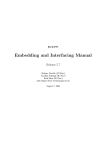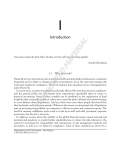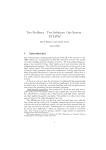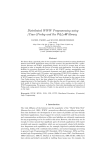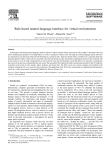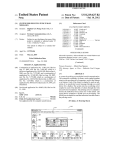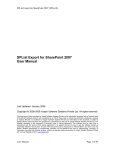Download A High-Level Generic Interface to External Programming
Transcript
A High-Level Generic Interface to External
Programming Languages for ECLiPSe
Kish Shen
Joachim Schimpf
Stefano Novello
Josh Singer
IC-Parc, Imperial College,
London SW7 2AZ
United Kingdom
Published in Practical Aspects of Declarative Languages, 4th International Symposium PADL 2002,
LNCS 2257, c Springer-Verlag
Some typos in the code listings have been corrected in this version
Abstract
This paper addresses an important but rarely discussed practical aspect of programming in a declarative language: its interface to other programming languages. We
present the high-level, generic interface of ECLi PSe , and discuss the reasons for our
design choices. The main feature of the interface is that it cleanly separates the code
for ECLi PSe from that of the external language, allowing the interface to be used for
different languages. We believe that many of the concepts developed for this interface
can be applied to other declarative languages, especially for other Prolog systems.
Keywords: Logic Programming, language interfaces, implementation, application development.
1 Introduction
An important practical aspect of a high-level programming language such as Prolog is
its interface to other programming languages. In a large scale programming setting, it is
unlikely that any one programming language will be used exclusively. In particular, the
strengths of Prolog which make it ideal for expressing and solving complex problems also
means it is not well suited for non-logical tasks such low-level programming and providing
a graphical user interface (GUI) to applications. Thus, it is important to provide means to
interface Prolog to other programming languages that are more suited to such tasks.
Many Prolog systems have interfaces to other programming languages, these generally
allow Prolog code to invoke commands/procedures written in another programming language (which we will refer to as the external language), and/or for code in the external
language to invoke Prolog predicates (if both directions are possible, the interface is said to
be bi-directional). The interfaces can be broadly classified into two categories by the level
of access to the internals of the Prolog system:
Low-level interfaces these provide the external language with direct access to the memory areas and low level representation of data structures of the Prolog system. The
external language is thus tightly coupled to the Prolog system, and able to manipulate the Prolog data structures and machine state. In fact, some form of such an
interface is normally used in the implementation of the Prolog system itself, as the
interface between Prolog and the language it is implemented in, which is usually C.
Because of the low-level nature of the interface, it is very system specific, and is
usually restricted to interfacing to the one language.
1
Allowing the Prolog data structures to be directly manipulated can be powerful and
efficient, but at the same time, it can be dangerous. It also requires the programmer
to have a reasonable knowledge of the Prolog system.
High-level interfaces these provide the external language with a less direct access to the
Prolog side. In particular, the external language is not able to directly access or
manipulate the Prolog data structures.
For many purposes, such as providing a GUI, low-level access to the Prolog state
is not required or even desirable. Furthermore, some programming languages (e.g.
script-based languages such as Tcl/Tk or Perl) are unsuitable for manipulating the
raw Prolog data structures in any case. In these cases, the data communicated between the two sides often have their own, separate, representations, and manipulating
the data on one side does not directly affect the other side.
There are of course many different programming languages, and different ways they
can be interfaced to Prolog. Many issues are involved in the design of such an interface,
and various interfaces have been developed for various Prolog systems to various programming languages. However, there has been little or no discussion in the published literature
about the reasons and issues behind the design of the interfaces. We feel that there are
common issues that are worth discussing, and in this paper, we present our experience with
developing a high-level interface for several external languages with ECLi PSe .
ECLi PSe is a constraint logic programming system being developed at IC-Parc. It is
used at IC-Parc, and its spin-off company, Parc Technologies, as the core for developing
industrial scheduling and planning applications. In the design of our external language interface, we needed to meet the commercial demands of Parc Technologies, and this strongly
influenced some of our design decisions, which will be discussed in this paper.
ECLi PSe has both a low-level, bi-directional, interface to C, and a high-level, also
bi-directional, interface to Java, Tcl/Tk and Visual Basic. In this paper, we concentrate
on the high-level interface because it involves issues which apply to other Prolog/Logic
Programming systems (and perhaps other declarative languages as well). This interface
was first introduced in version 4.1 of ECLi PSe , released early in 1999, and evolved to its
current form described here.
2 Motivation and Objective
Our main motivation for the development of a new external interface was to allow our
ECLi PSe applications to be used within larger applications written in different languages.
We also wanted to implement a robust development GUI for ECLi PSe , and provide a stable
basis for a multitude of GUIs for various ECLi PSe applications in the future.
From experience with previous external language interfaces and requirements for our
applications, we had several issues and objectives in mind while we were developing the
interface:
Language generic We did not want an interface that was specific to a particular language.
Developments in programming languages mean that a language in favour today may
no longer be so in the future. Also, in commercial settings, there may be specific
requirements to use a particular language, e.g. a client for one of our commercial
applications explicitly required Visual Basic as the external interface language, while
at the time we provided a Tcl/Tk interface.
We wanted an interface that is generic in the sense that the ECLi PSe side is independent of the languages used on the external side. Thus an agent written in a different
programming language can be substituted on the external side without changing any
code on the ECLi PSe side of the interface. In addition, while the syntax on the
2
Peer #2
Peer #1
yield
yield
resume
resume
ECLiPSe
agent
yield
resume
Peer #n
Figure 1: The Generic External Interface with Multiple Peers
external side would certainly differ from language to language, they should all implement the same concepts, so it should be easy to move from using the interface in
one language to another.
Maintenance We wanted to minimise the development/maintenance overheads to support
a new language via the interface. Thus, when interfacing to a new language is required, we can rapidly develop the interface required.
Control When ECLi PSe is interfaced to an external language, we often need to mesh the
very different control regimes of the two languages: ECLi PSe is non-deterministic
and single-threaded, and the external language tend to be deterministic and multithreaded. We wanted to avoid complex control flow between the two languages,
as this can easily lead to unmanageable nesting and interactions between the two
languages.
Syntax We wanted to avoid any conflicts in syntax between ECLi PSe and the external language, which could happen if commands or data structures in the external language
can occur in their native syntax within the ECLi PSe side and vice-versa. Allowing
syntax of one language to appear in another is always error prone, especially for
quoting of special characters (which are likely to be different in the languages), and
when the command may be assembled dynamically during execution.
Uniform Usage We wanted to have a uniform interface, no matter whether ECLi PSe was
used as a library (embedded into an external language host program) or as a server
(in a separate process, possibly on a remote machine).
2.1 Conceptual Model
We developed a message-based, data-driven interface, as shown in Figure 1. The interface connects one agent written in ECLi PSe with one or more agents written in external
languages.
The main conceptual points of the interface can be summarised by:
Multiple agents Multiple external agents can be connected to an ECLi PSe agent via the
interface, and the connection itself may be by different methods. The interface provides
the concept of peers to allow these external sides to be accessed in a uniform way. A peer
is any external side (i.e. the external agent and its connecting peer queues).
Data-driven queues The two sides are connected by I/O queues with data-driven handlers, called peer queues. The interface provides operations to set up peer queues that
connect the two sides. These are I/O queues that can send messages between the two sides
in one direction. If the direction of data flow is from ECLi PSe side to the external side,
3
the queue is called a from-ECLi PSe queue; if the data flow is from the external side to
ECLi PSe , it is called a to-ECLi PSe queue.
For each peer queue, a handler can be defined to handle the data transfer. These are
procedures (or predicates in ECLi PSe ) which are invoked to handle the transfer of data. The
handler can either be a data provider, which supplies data to the other side when requested
(when the other side reads from the queue and no data is available); or be a data consumer,
which consumes data arriving on a queue. The execution of the handler for a queue is thus
driven by the data transfer on that queue.
Structured messages To allow for platform and language independent interchange of
typed data on the queues connecting the two sides, an ECLi PSe external data representation (EXDR) format was defined. EXDR allows the representation of a large subset of
ECLi PSe ’s data types, including lists and nested structures. EXDR was inspired by Sun
Microsystem’s XDR format [7], however, unlike XDR, every EXDR term also includes its
own type information.
Synchronous control flow Conceptually, there is a single thread of control flow between
the external and ECLi PSe sides. At any time, one side has control, and only it can initiate
the transfer of data on the queues (i.e. either sending data to the other side, or requesting
data from the other side). On the ECLi PSe side, execution is suspended while the external
side has control. Execution on the external side may or may not be suspended1 while
ECLi PSe side has control, depending on the programming language and/or the platform.
ECLi PSe remote predicate call (ERPC) The queue handlers already provide all the
means for invoking actions in both directions. For convenience, and because an external
side is always interfaced to an ECLi PSe agent, a form of Remote Procedure Call [1], which
we call ECLi PSe Remote Predicate Call (ERPC) is always provided. It allows an external
agent to conveniently invoke deterministic ECLi PSe predicates and retrieve their results.
3 Design Details
3.1 Peers
In the conceptual view of the interface, the way an external agent is connected to an
ECLi PSe agent is not important, only that the two sides can communicate via data-driven
peer queues. Thus, different concrete realisations of the interface are possible. We have
provided two: an embedded variant, where the ECLi PSe agent and the external agent are
in the same process (communicating through main memory); and a remote variant, where
the ECLi PSe and remote agents are separate processes (connected by TCP/IP sockets). In
the latter case, as the connections are sockets, the two agents can be located on different
machines.
An ECLi PSe agent can be embedded into only one external agent. Multiple remote connections (perhaps to agents of different external languages) can be made, and any ECLi PSe
agent can be connected, including one that is already embedded, i.e. an ECLi PSe agent can
have at most one embedded peer, but multiple remote peers.
The differences between the embedded and remote interface variants are largely abstracted away by the unified conceptual view and the concept of peers. From the programmer’s point of view, the remote and embedded variants can be largely used in the same
way, and code written for one can be reused for the other. This is achieved by providing
the same predicate/procedure names/methods interface calls with both variants on both the
ECLi PSe and external sides.
1 if
execution is not suspended, then it cannot initiate data transfer to the ECLi PSe side.
4
The one main difference visible to the programmer is the process of initialising and
terminating the connection with the two interfaces. With the embedding interface, the
ECLi PSe agent is started from within the external agent (the agent loads ECLi PSe as a
library), and the connection terminated by terminating the ECLi PSe agent. With the remote
interface, the external agent has to be explicitly attached to the ECLi PSe agent for the
connection, and detached for the termination. Attachment establishes an initial control
connection between the two sides, along with some initial exchange of information. The
control connection is used to co-ordinate and synchronise subsequent actions.
As an example of the use of both variants, the TkECLi PSe development tools (a set of
development tools including debugger and state browsers), which were originally written
to be used in an embedded setting together with the TkECLi PSe toplevel GUI, runs in the
remote setting with very few modifications, even though the bulk of the code was developed
before the conception of the remote interface. In terms of code sizes, there is about 4260
lines of Tcl and 1750 lines of ECLi PSe code that are shared. The specific code for starting
the tools with the remote interface is about 200 lines of Tcl code and 60 lines of ECLi PSe
code. About 30 lines of Tcl code and no ECLi PSe code would be needed to start the
development tools with the embedding interface.
3.2 Peer Queues
The peer queues are implemented differently in the embedded and remote setting. In the
embedded case the queues are shared memory buffers, while in the remote case the queues
are implemented with sockets connecting the two sides.
To a user, a peer (once it is set up), whether remote or embedded, can be treated in
the same way. Information is transferred between the two sides via the peer queues, which
are created in a uniform way. The creation can be initiated from either the ECLi PSe or
the peer side. From the ECLi PSe side, the difference between a remote peer queue and an
embedded peer queue is hidden by providing the same predicate to create the queue – the
user just specifies which peer the queue is for, and then the appropriate queue is created.
3.3 Typed EXDR Messages
The EXDR encoding is instrumental in providing language and architecture independence
for the interface. Similar to XML [11], and unlike XDR, EXDR data includes type information. This is implemented in a very compact way by tagging each data item with a byte
that identifies the particular data type. This allows the type of the data sent to be dynamically determined when the data is sent, rather than being statically fixed, and is particularly
useful for a dynamically typed language like Prolog.
The data types that are available in this format are listed in Figure 2. The idea is to
represent that subset of ECLi PSe types which has a meaningful mapping to many other
languages’ data types. Apart from the basic types, lists and nested structures are available
and are mapped to meaningful types in many external languages. The main restriction is
that logical variables (which have no equivalent in most other languages) are not allowed
in their general form. However, singleton occurrences are allowed and useful to serve as
place-holders, e.g. for result arguments in ERPCs (see section 3.7)
A small difficulty arises with a language like Tcl whose type system is too weak to
distinguish between all the EXDR types: different EXDR types map to the same string in
Tcl. While this is usually no problem when Tcl receives data, we have augmented the Tcl
send primitive to take an additional argument which specifies the EXDR type into which a
given string should be encoded.
The complete specification including the concrete physical encoding for the EXDR
format is given in [6] and appendex A. As part of the external side of the interface for a
particular external language, the mapping of EXDR data types into that language must be
defined.
5
EXDR type
Integer (32bit)
Long (64bit)
Double
String
List
Nil
Struct
Placeholder
ECLiPSe type
integer
integer
float
string
./2
[ ℄ /0
compound
anon variable
Tcl type
int
string
double
string
list
string ””
list
string ” ”
VB type
Long
n/a
Double
String
Collection of Variant
Collection of Variant
Array of Variant
Empty Variant
Java type
java.lang.Integer
java.lang.Long
java.lang.Double
java.lang.String
java.util.Collection
java.util.Collection
CompoundTerm
null
Figure 2: EXDR types with some language mappings
Ec1
Ex1
Ec2
Ex2
Ec2
Ex1
Ec1
ECLiPSe
External
Figure 3: Nesting of Handlers
3.4 Control Flow
The control flow between the two sides is based on the synchronous yield/resume model:
Control is transferred from ECLi PSe to the external side when ECLi PSe yields to the external side. Control is transferred from the external side back to ECLi PSe by resuming
ECLi PSe . For example, when data is transferred from ECLi PSe to the external side on a
peer queue, ECLi PSe will yield to the external side to allow the external side to process
the data (via a handler for the queue). When the external side completes the processing,
control is returned to the ECLi PSe by resuming ECLi PSe .
Note that handler execution on the two sides can be nested. An example of this is shown
in Figure 3. In the figure, time advances down the page, and the figure shows the transfer of
control between the ECLi PSe and remote sides. A vertical line shows that a particular side
has control, and the horizontal arrows shows the transfer of control. Initially, the ECLi PSe
handler Ec1 is executing, and ECLi PSe has control. At some point, control is transferred
to the external language, and the external handler Ex1 is invoked. This transfers control
back to ECLi PSe , starting a new handler Ec2 (the line is thicker to more readily distinguish it from Ec1), which in turn invokes an external handler Ex2. When Ex2 completes,
control is returned to ECLi PSe and the execution of Ec2 continues until it also completes
and returns to the remote side, where Ex1 continues and completes, returning control to
ECLi PSe , which continues the execution of Ec1. Thus, Ex2 is nested within the execution
of Ec2, which is nested within Ex1, which is nested within Ec1. This nesting allows the
implementation of the equivalent of the ‘call back’ functionality of traditional RPCs.
The thread-based control flow limits the complexity of interactions between the two
sides. As ECLi PSe has only a single thread of execution, it would not be sensible to allow
6
the external side to request execution of other goals while ECLi PSe side has control and is
executing a goal. Note that the external side is not limited to being single threaded (and in
fact neither Java or Tcl are single threaded).
The topology for transferring control with multiple peers is always a star shape with the
ECLi PSe agent in the middle: control is handed over from the ECLi PSe agent to a peer,
which can then only hand back control to that ECLi PSe agent. This is shown in Figure 1.
3.5 Generic invocation of action
We achieve language independence in our interface by using the generic concept of queues
over which messages in the language independent EXDR format are transferred. We did
not provide any built-in method to directly execute commands of the external language
from within ECLi PSe . Nevertheless, ECLi PSe can cause actions to take place on the external side. The idea is that instead of making a procedure call directly, data transfers on a
queue are used to invoke the handler for the queue. The data transferred specifies how the
procedure should be invoked. The ECLi PSe side can thus regard the remote side as a black
box, where the programming of a particular queue just involves specifying the protocol for
transferring data and what the data is for. None of the details of how the data would be
processed need to be known on the ECLi PSe side – all the code for doing this remains on
the remote side. In particular, a different language can be substituted on the remote side,
and as long as the handler for the queue obeys the same protocol, nothing on the ECLi PSe
side is affected by the change.
3.6 Generic interface within the external language
The key abstractions of peer and of a peer queue allow natural counterpart abstractions on
the external side, which can give a highly flexible underlying architecture. Abstraction is a
strong element of object-oriented language such as Java, and our Java side of the interface
demonstrates this. Just as a peer is a generic interface to an external side of any kind, the
EclipseConnection interface in our Java code is implemented by different classes providing
a connection to an ECLi PSe engine. For example EmbeddedEclipse implements EclipseConnection in the embedded variant of the interface; and RemoteEclipse class on the other
hand implements EclipseConnection in the remote variant. Just as a peer queue allows
communication between ECLi PSe and any kind of peer, so the Java classes FromEclipseQueue and ToEclipseQueue are provided by any class implementing EclipseConnection.
3.7 ERPC
The ERPC mechanism is provided for ease of programming. It is implemented on top of
a pair of peer queues (to- and from-ECLi PSe ), with the handler for the to-ECLi PSe queue
reading the goal (in EXDR format), executing it, and returning the resulting goal to the
external side. The handler essentially looks like:
erpc_handler :read_exdr(rpc_in, Goal), once(Goal), write_exdr(rpc_out, Goal).
The actual ERPC handler code deals with failures and exceptions as well. These queues and
the handler are pre-defined by the ECLi PSe -side of the interface, along with the handler.
Since we are interfacing to a variety of different external languages, none of which have
concepts of logical variables, backtracking or goal suspension, the kind of ECLi PSe goals
that can be called through the interface must be restricted. The abstraction of an ECLi PSe
goal which the interface provides to the external language is that of a procedure with input
arguments and output arguments which expect/return data of certain EXDR types.
On the ECLi PSe side that means that (i) externally callable goals are limited to return
only one solution by committing to the first one, (ii) all variables in input arguments will
7
be singleton variables and can only be used to return results, (iii) results cannot contain
shared variables. It is in the responsibility of the ECLi PSe programmer to provide callable
predicates that observe these restrictions. In practice that means that e.g. difference lists
need to be transformed into standard lists, and multiple solutions can be either collected
and returned in a list, or alternatively returned incrementally via a dedicated, applicationspecific peer queue (as demonstrated in the map coloring example of section 5).
Since the external languages have different, incompatible argument passing conventions, especially for output arguments, we decided on an ERPC protocol that is at least
natural and easy to implement on the ECLi PSe side: the goal is sent as a compound term,
which may contain one or more singleton variables as placeholders for the output arguments. To return the result after successful execution, we send back the complete original
goal, but with the former variables replaced by result values. This method avoids the need
for a complex return-result protocol involving variable-handles or identifiers. It does however requires the external side to extract the results from the goal term. This protocol is
suitable for most rpcs except those that have very large input arguments. In this latter case,
the programmer would set up a queue for sending the input separately.
4 Discussion
4.1 Separation of ECLi PSe and external code
The interface clearly separates the code for ECLi PSe and the code for the external language. This means that the ECLi PSe code and the external code can be developed separately with just the interchanges between the two languages clearly specified. In particular,
it means that
Any problems with incompatibilities between the syntax of ECLi PSe and the remote
language is avoided.
The same ECLi PSe side of the interface can be used for different languages. There
is no need to learn to use a different interface if the external language is changed.
The development of the interface for a new external language means only a new
external side of the interface has to be developed.
The programmers on one side need not have much knowledge about the other programming language. In the case of Parc Technologies, this means that GUI and Java
programmers can be hired without requiring them to either already know or undergo
extensive training in ECLi PSe or Prolog.
The converse is also true: ECLi PSe and CLP programmers do not need expertise or
knowledge in GUI or Java programming.
Each language is left to do the tasks they are most suited for. We do not need to
‘enhance’ ECLi PSe to provide features for tasks it is not suited for. For example, to
properly support GUIs, a language needs to support some notion of multi-threading
or an event-loop to cope with the inherently reactive nature of the task. As none
of this management of the GUI is done on the ECLi PSe side, there is no need to
introduce such features to ECLi PSe .
Where the external language is used for providing a GUI, then the core part of the
ECLi PSe code can often be easily detached from the interface and used separately.
This is particularly convenient for both development and unit-testing of the ECLi PSe
code.
8
4.2 Supporting a New External Language
The ECLi PSe side and the external side are loosely coupled, and have few dependencies
on the low-level workings of either ECLi PSe or the external language.
To implement the embedded variant of the interface, the external language system must
be able to load ECLi PSe as a library and to invoke a subset of the functions provided by
ECLi PSe ’s C/C++ interface. These are the functions needed to initialise and finalise the
ECLi PSe engine and to access the memory queue buffers.
For the remote variant of the interface, the remote side of the interface protocol has to be
implemented, i.e. sending the appropriate message at the appropriate time, and performing
the right actions on receiving messages from the ECLi PSe side. The protocol is specified
in the ECLi PSe Embedding and Interfacing manual. This code should be straightforward
to write and basically requires that sockets can be programmed in the language.
Both interfaces also need to provide support for the EXDR format, i.e. encoding/decoding
native data into/from EXDR format. Depending on the external language, this may need
to be supported at the C level (for example, in Tcl this is done in C, in Java this is done in
Java).
Our experience so far is positive: the interface was initially developed mainly for use
with Tcl/Tk for the development of the GUI for ECLi PSe itself. Since then, Parc Technologies have decided to standardise on using Java for all their GUI (and any other nonECLi PSe ) development, and support through this interface for Java was rapidly developed,
both in the embedded and remote variants.
We could also confirm the reusability of the ECLi PSe side code with different external
languages: parts of the ECLi PSe development GUI that was written in Tcl originally have
been successfully replicated in Visual Basic or Java. However, with the introduction of the
peer concept, this replication is now rarely necessary, as GUI components can be written
in different languages.
4.3 Synchronous Control Flow
In our interface, the interaction between the external and ECLi PSe sides is synchronous.
We deliberately avoided the complexity of a general message passing system, which would
be difficult to combine with the already complex control flow in a constraint programming
system.
As control is transferred for each exchange of data, and when the external side has control, ECLi PSe execution is suspended, there might be a problem with efficiency. However,
as discussed in section 2.1, the execution of the external agent is not necessarily suspended
while ECLi PSe side has control. In a multi-threaded external language like Java, the data
can be read by the Java side and control returned to ECLi PSe side quickly while the Java
side then processes the data concurrently.
With our current main area of application, the provision of GUIs, efficiency does not
seem to be a problem. Asynchronous communications can be programmed separately,
using standard sockets, if necessary.
4.4 Scope of Applicability
The high-level interface is a general interface to an external language, and is of course not
limited to allowing the external language to providing GUIs for ECLi PSe applications.
The different strengths of the embedding and remote variants of the interface makes
them suitable for different uses. Some of the issues to consider are efficiency, flexibility,
security and fault tolerance.
9
4.4.1 Efficiency
The memory buffers of the embedded interface offer faster communications between the
two sides than the socket connections of the remote variant. With the remote interface,
data sent from one side needs to be physically transmitted (via sockets) to the other side,
perhaps with buffering on both sides. TCP/IP also imposes an overhead on each transmission of data, such that it takes tens of milliseconds per transmission, regardless of the size
of data transmitted, even when the two sides are on the same machine. This means that
for applications where there are frequent exchanges of data, the process can be noticeably
slowed by the interface. In some situations, it might be possible to reduce the number of
times the control is transferred by pooling the updates and sending them in batches.
4.4.2 Flexibility
The flexibility of connecting to multiple external agents via the remote interface is quite
useful. For example, Parc Technologies decided to standardise on using Java for all its nonECLi PSe coding, while the ECLi PSe graphical development tools are written in Tcl/Tk.
With the initial embedding interface, these tools were only available to programs which
also used Tcl/Tk for their GUI, but the remote interface allows these tools to be used in
conjunction with a Java agent, making the process of development much easier. The multiple agents approach will also allow new tools to be developed in Java, without needing to
recode all the existing development tools into Java.
The remote interface allows an ECLi PSe agent to be run remotely, on any machine that
can be reached via the internet. One use for this is to allow an ECLi PSe program to be
debugged remotely.
A practical advantage for the remote interface that we did not initially foresee is that
the memory and other resources are not shared between the ECLi PSe and external agents.
In the embedding interface, our experience with programming large applications in Java,
ECLi PSe and also other software systems such as an external Mixed Integer Programming
solver, all doing their own memory management and all interacting as a single process,
non-repeatable problems (perhaps due to some memory leak) do occur that are difficult to
track down. In the remote interface, bugs caused by the interaction of different memory
management are less likely to occur, and any bugs which do occur are easier to track down.
4.4.3 Security
Potentially, because the remote interface allows connections from anywhere reachable on
the network, the remote side can be ‘hijacked’ by an imposter, and once attached, it has
full access to the ECLi PSe side through ERPC, and hence to the ECLi PSe side’s file space.
The remote protocol implements a ‘pass-term’ check, where an ECLi PSe term is transmitted from the remote side to the ECLi PSe side and checked before the socket connection for
the ERPC is allowed. Another method to limit access is to allow attachment on the local
machine only via the loopback address. Further security can be imposed by the programmer, e.g. encryption of the data transmitted on the queues.
4.4.4 Fault-tolerance
With the remote variant, there is the possibility that the connection between the two sides
may be lost unexpectedly, either because of some network problems, or because one side
dies unexpectedly. In such cases, the peer queues will be disconnected, and when one side
detects this, a unilateral detachment will be performed by the remote protocol, and control
is returned to the programmer to deal with this unexpected situation. In the embedded
variant, the two sides are in the same process, so the problem does not arise.
10
get_map_data/1,
colouring/5
ERPC queues
map data
file
Main
yes no
continue queue
country/5, end/0
setup_map queue
colour/2
update_map queue
ECLiPSe Agent
setup
handler
update
handler
External Agent
Figure 4: Structure of Map Colouring Program
5 An Example – Map Colouring
In the ECLi PSe distribution, there is an example illustrating the use of the interface. Currently Tcl/Tk is used as the external language, providing a GUI for the main ECLi PSe
code, which solves the standard map colouring problem where a map of countries should
be coloured with four colours such that no neighbouring countries share the same colour.
The overall structure of the program is shown in Figure 4. In brief, the ECLi PSe agent
can colour a map by several different methods, using the map data specified in a map data
file. The external agent provides the GUI for the user to select the map, and how many
countries from the map, should be coloured; method of colouring the map, and also for
displaying the map as it is being coloured by the ECLi PSe agent. Finally, when the map is
successfully coloured, the external agent allows the user to ask for more solutions.
The two sides communicate via ERPCs, and three peer queues:
setup map : this from-ECLi PSe queue transmits the shape and position information of a
map to the external side, which uses the information to construct the map.
update map : this from-ECLiPSe queue transmits the information for updating the map
as it is being coloured by the ECLi PSe program.
continue : this to-ECLi PSe queue transmits the request for further solutions once the map
is coloured.
The ECLi PSe code consists of two main components: the setting up of the map for the
external side in get map data/1, and the colouring of the map in colouring/5. The
abstract outline of the code relevant to the interface is as follows:
get_map_data(Size) :....
write_exdr(setup_map, country(C,X1,Y1,X2,Y2)),
....
write_exdr(setup_map, end)
colouring(Type, Select, Choice, Size, Time) :....
( write_exdr(update_map, colour(C, Colour))
; write_exdr(update_map, colour(C, gray)), fail
),
....
read_exdr(continue, Continue),
Continue == no.
get map data/1 sends the data for the map to be coloured to the external side. The full
map has been read into the ECLi PSe side earlier by another predicate (not shown here).
11
Size specifies how many countries from the full map are to be coloured: configuration
information on Size countries are sent to the external side. This information is sent in a
loop, consisting of a series of country/5 terms, terminating in a end term.
colouring/5 does the actual colouring of the map. The first four arguments specify
various options, and the last argument Time is an output argument for returning the cpu
time consumed for colouring the map. When a country C is set to a particular colour
Colour during the colouring process, this information is sent to the external side via the
update map queue; a choice-point is created so that the colour can be reset (to gray) when it
is backtracked over. Finally, when the map is successfully coloured, the program reads from
the continue peer queue. This hands control over to the external side, where the user
can specify via the GUI if the program should continue and return another solution or not.
By clicking on the appropriate widget, either yes or no is sent via the continue queue to
the ECLi PSe side, and read exdr/2 on the ECLi PSe side returns. The execution then
either backtracks to get the next solution or finishes.
Both predicates are called from the external side via ERPC calls, with the ERPC invoked when the user clicks on the appropriate widget in the GUI.
This example shows the generic nature of the interface concretely: the ECLi PSe side
of the code does not depend on the external side being Tcl. Another external language can
be used to provide the GUI, as long as the implementation follows the protocol defined
above. The actual example program in the distribution can also be run either embedded or
remotely.
For illustration, we outline the Tcl code for handling the map colouring:
proc run {} {
....
;# calling colouring/5, followed by the type information
ec_rpc [list colouring $solver $select $choice $mapsize _] (()()()I_)
....
}
proc update_map {...} {
....
;# read the colour/2 term
set info [ec_read_exdr update_map]
;# extract the country and colour from the data and display it
set country [lindex $info 1]
set colour [lindex $info 2]
....
}
proc continue_colouring {continue_queue} {
global continue_state
....
;# wait for user to decide if more solution is wanted
tkwait variable continue_state
....
;# send decision to ECLiPSe
ec_write_exdr $continue_queue $continue_state ()
....
}
run is a procedure invoked by pressing a ‘Run’ button which starts the colouring process.
This procedure makes an ERPC call. As discussed previously, for a weakly typed language
like Tcl, type information has to be specified (the (()()()I ) string, see the manual [6]
for more details).
12
While colouring/5 is running, it sends the colour information as described above.
On the Tcl side, this invokes the handler update map, which reads the information from
the update map queue and displays it.
continue colouring is the handler procedure for the continue queue. When
ECLi PSe reads from the queue, this procedure is invoked on the Tcl side. The Tcl code
waits for the continue state variable to be set by the appropriate widgets (buttons that the
user clicks to specify if another solution is wanted). This variable is set to either yes or
no, and the information is returned to the ECLi PSe side.
6 Related Work
Many existing Prolog systems provide some form of external language interface. Most of
the earliest are ‘low-level’ interfaces to C. Interfaces to Tcl/Tk and, more recently, to Java
and Visual Basic have been developed. For script languages such as Tcl/Tk, the interface is
usually high-level, because Tcl itself cannot represent or manipulate the raw representation
of Prolog data structures. On the other hand, Java interfaces can be either high-level or
low-level.
Examples of high-level interfaces include the old ProTcXl [5] of ECLi PSe ; the Tcl/Tk
and Visual Basic interfaces of SICStus [8]; the Tcl/Tk and Java interfaces of Ciao [2]; the
Tcl/Tk interface of BinProlog and ProLog by BIM [9].
Most of these interfaces are not generic; for example, the Visual Basic, Tcl/Tk and Java
interfaces of SICStus are very different from each other, and so are the Tcl/Tk and Java
interfaces of Ciao. In fact, Java interfaces can be low-level like C interfaces, allowing the
Java program to directly access the Prolog data. An example of this is Jasper, the Java
interface of SICStus. Foreign language interfaces tend to be complex (this can be seen by
simply looking at the amount of documentation that the manuals need to dedicate to their
description). We hope that having a generic interface will significantly reduce the learning
curve for the user.
The design of our interface was motivated partly by our experience with ProTcXl, an
earlier interface for ECLi PSe to Tcl/Tk, which we abandoned in favour of starting afresh
with the generic interface. We designed the new interface to overcome some of the problems of ProTcXl: it was Tcl specific, had a complex control scheme that inexperienced
programmers often got wrong, allowed Tcl commands in Tcl-syntax to be assembled and
called within the ECLi PSe code, which often lead to incorrect parsing by the Tcl interpreter. In contrast, the new interface is not Tcl specific, has a much simpler control flow,
and does not provide for executing Tcl commands directly within the ECLi PSe code. In
addition, there are less low-level ‘glue’ code, so maintenance and portability should be
easier.
Our interface avoided the problem of syntax conflicts between the external language
and Prolog by avoiding the specification of external procedures from within Prolog code.
Other ways of avoiding this problem are:
Wrapping the components of a command with ‘type-wrappers’ so that they would
not be mis-identified. An example of this is Ciao’s Tcl/Tk interface.
Specifying the external command in Prolog syntax, and perform on-the-fly translation into the external language. This was the approach taken with BinProlog’s Tcl/Tk
interface. It offers the possibility that the command may be executed in a different
external language with a different translator. However, this approach may have some
problems with statically and strongly typed languages.
The Ciao Java interface has some interesting similarities to ours. The two sides are
also connected via sockets, and a serialised representation of Prolog terms and Java object
references is used to transport data between the two sides. Actions on both sides can be
13
invoked via event handlers. One main difference from our interface is that the interaction
between the Prolog and Java sides appear more complex than in our scheme, and requires
the Prolog side to be multi-threaded. With our more simple control scheme, we do not need
threads.
An alternative to providing external interfaces directly might be to use a ‘middle-ware’
layer like Corba [10], which will allow RPC calls, but at the price of an additional software
layer, and an unnatural match of the object oriented aspects of Corba and ECLi PSe (which
currently does not have an interface to Corba). The main difference between an interface
specified in Corba IDL versus one in ECLi PSe EXDR would be that the IDL typing is more
rigid and does not offer such a natural match with ECLi PSe /Prolog data types. Another
concern is that Corba is mainly designed for network interoperability, and having unified
embedded and remote versions would require the definition of a suitable subset.
Of course, there is nothing inherent in our interface that would limit it to a Logic Programming language. It should be equally applicable to Functional Programming languages.
We are not aware of any direct equivalent in Functional Programming languages: although
foreign language interfaces also exist for Functional Programming languages, many such
interfaces seem to be targeted to C. HaskellDirect [3] allows Haskell to be interfaced to
an external language, generating the necessary code to make function calls (and be called
from an external language) by specifying the ‘signatures’ for functions in an Interface Definition Language, which is then compiled by HaskellDirect. Although it can be used to
interface to different languages, it seems to be mainly targeted for C. Unlike our interface,
function calls are to be made directly in the language, instead of just passing the data. An
example of a non-C foreign language interface is sml tk [4], which is an interface to Tcl/Tk
for Standard ML. This interface is quite tightly coupled to Tcl/Tk, and probably cannot be
used to interface to another language.
7 Conclusion
We have presented the ECLi PSe high level external language interface. Since its initial
development two years ago, this interface has been used extensively by us. The Java interface is being used for all the commercial applications that Parc Technologies is developing.
The interface has also been used for a development GUI toplevel for ECLi PSe , and a set of
development tools that can be accessed from the toplevel and other ECLi PSe applications
that use the embedded Tcl/Tk interface, and through the remote interface, the development
tools can be used with any ECLi PSe process. The Tcl/Tk interface was also used in an
application that IC-Parc was developing for a customer.
We believe that the interface offers advantages over previous external language interfaces in that it cleanly separates the ECLi PSe (Prolog) and the external code. This allows
the interface to be generic and eases our development and maintenance efforts.
Acknowledgements
The authors gratefully acknowledge the invaluable help that our colleagues at IC-Parc and
Parc Technologies for their feedback and discussions on the development of the interface.
We also thank Mark Wallace for his quick feedback and comments on this paper. We also
thank the referees for their comments.
14
A
The EXDR Format Specification
ExdrTerm ::= ’V’ Version Term
Term
::= (Integer|Double|String|List
|Nil|Struct|Variable)
Integer ::= ’I’ XDR_int | ’J’ XDR_long
Double
::= ’D’ XDR_double
String
::= ’S’ Length <byte>*
List
::= ’[’ Term (List|Nil)
Nil
::= ’]’
Struct
Variable
Length
Arity
Version
XDR_int
XDR_long
XDR_double
::=
::=
::=
::=
::=
::=
::=
::=
’F’ Arity String Term*
’_’
XDR_int
XDR_int
<byte>
<4 bytes, msb first>
<8 bytes, msb first>
<ieee double, exponent first>
References
[1] A. D. Birrell and B. J. Nelson. Implementing Remote Procedure Calls. ACM Transactions on Computer Systems, 2(1), Feb. 1984.
[2] F. Bueno, D. Cabeza, M. Carro, M. Hermenegildo, P. López, and G. Puebla. The Ciao
Prolog System Reference Manual, 2000.
[3] S. Finne, D. Leijen, and E. Meijer. Calling Hell from Heaven and Heaven from Hell.
In Proceedings of the International Conference on Functional Programming. ACM
Press, 1999.
[4] C. Lüth and B. Wolff. sml tk: Functional Programming for Graphical User Interfaces, Release 3.0.
[5] M. Meier. ProTcXl 2.1 User Manual, 1996.
[6] S. Novello, J. Schimpf, J. Singer, and K. Shen. ECLiPSe Embedding and Interfacing
Manual, Release 5.2, 2001.
[7] R. Srinivasan. XDR: External Data Representation Standard. Request for Comments
(RFCs) 1832. The RFC Editor, Sun Microsystems, Inc., 1995.
[8] Swedish Institute of Computer Science. SICStus Prolog User’s Manual, 1995.
[9] P. Tarau and B. Demoen. Language Embedding by Dual Compilation and State Mirroring. In Proceedings of the 6-th Workshop on Logic Programming Environments,
ICLP94, 1994.
[10] S. Vinoski. CORBA: Intergrating Diverse Applications Within Distributed Hetrogeneous Environments. IEEE Communications, Feb. 1997.
[11] W3C. Extensible Markup Language (XML) 1.0 (Second Edition), 2000. available at
url: http://www.w3.org/YR/2000/REC-xml-20001006.
15



















